Asian cuisine is a global favorite, celebrated for its bold flavors, communal dining style, and vibrant presentation. But mastering the art of the perfect Asian meal goes beyond just the cooking. It extends to the dining experience itself, starting with the table setting for Asian family meals and formal gatherings. If you’ve ever wondered how to set the table for Asian countries, this comprehensive guide is for you.
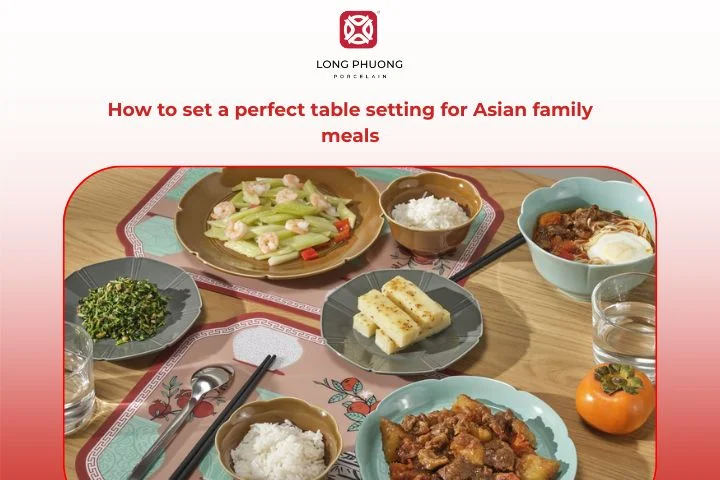
1. The essence of an Asian table setting
Unlike the Western tradition, where the focus is often on individual place settings with multiple pieces of cutlery, the table setting for Asian priority communal dining, practicality, and harmony.
The typical Asian meal involves multiple dishes placed in the center of the table, allowing everyone to share. This communal style requires a setting that is functional yet inviting, allowing easy access to the shared food while providing the essential tools for each diner.
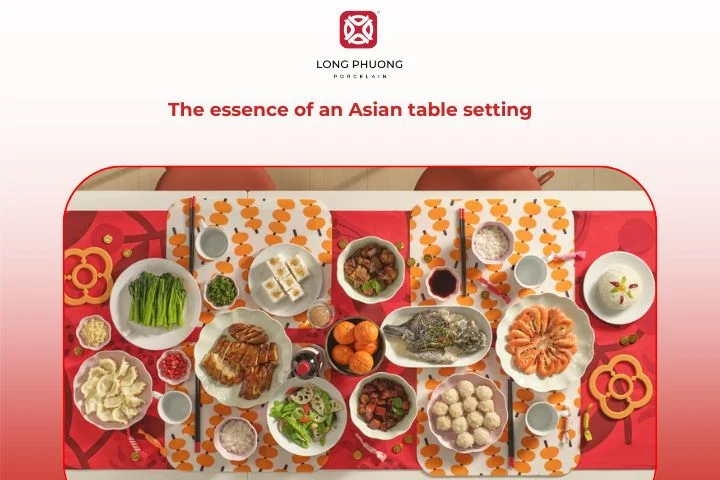
2. 6+ essential items for a table setting for Asian homes
Every Asian dining experience starts with carefully selected dinnerware. Here are the must-have items for a complete table setting for Asian homes:
2.1. Tableware set
A cohesive tableware set includes plates, bowls, and sauce dishes designed to any sophisticated table setting for Asian dining. Porcelain is highly preferred for its durability and elegant shine, often used in both everyday and festive settings.

2.2. Rice bowls
Rice is the heart of every Asian meal. Each guest usually has a small rice bowl placed directly in front of them. Choosing the right rice bowl is critical to the authentic table setting for Asian style. For a touch of sophistication, choose fine porcelain bowls that retain heat while keeping the texture of rice soft and fluffy.
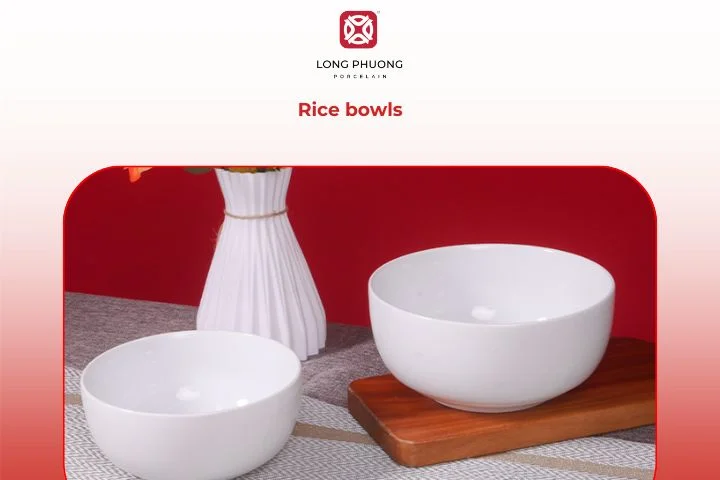
2.3. Soup bowls
While individual diners may have small bowls for dipping or sipping, a larger soup bowl is essential for holding the communal broth or main soup dish, placed in the center of the table.

2.4. Plates
Plates serve two main functions:
- Serving Plates: Large, central plates or platters holding the main dishes (meat, fish, vegetables) for communal sharing.
- Individual Plates: Smaller plates placed at the setting for holding appetizers, side dishes, or bones/waste.
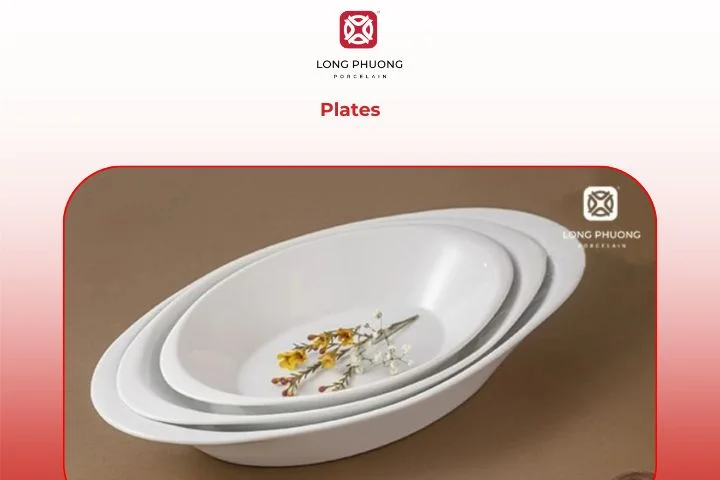
2.5. Chopsticks
The primary utensil for eating solid food. Chopsticks are placed neatly together to the right side of the bowl. Their material (bamboo, wood, or porcelain) can add a beautiful cultural touch.
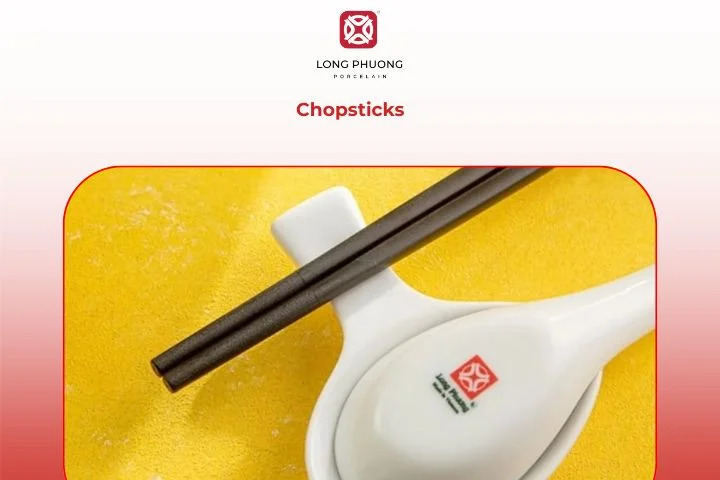
2.6. Spoons
Often ceramic or metal, spoons are primarily used for consuming soup or broth and are generally placed to the right of the chopsticks.
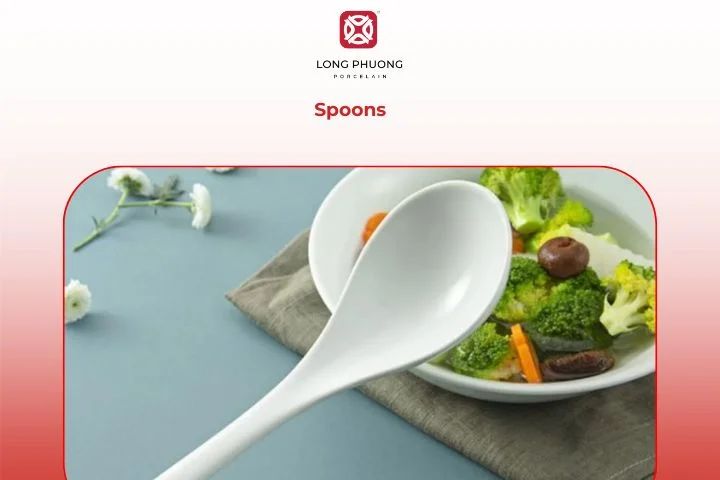
2.7. Sauce dishes
These small, shallow sauce dishes are indispensable. They hold individual portions of dipping sauces like soy sauce, chili oil, fish sauce, or vinegar. They are placed slightly above and to the left of the main bowl.
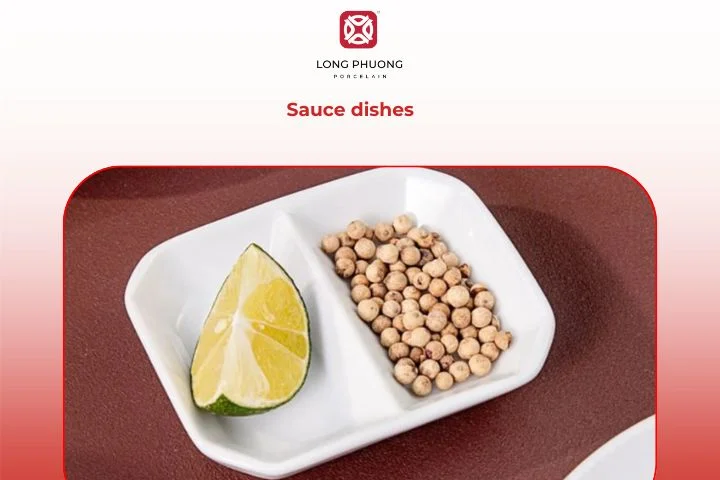
3. How to set the table for Asian countries
While the core essentials are similar, specific traditions vary greatly across the continent. Understanding these nuances is crucial for an authentic table setting for Asian dining.
3.1. Vietnamese table setting
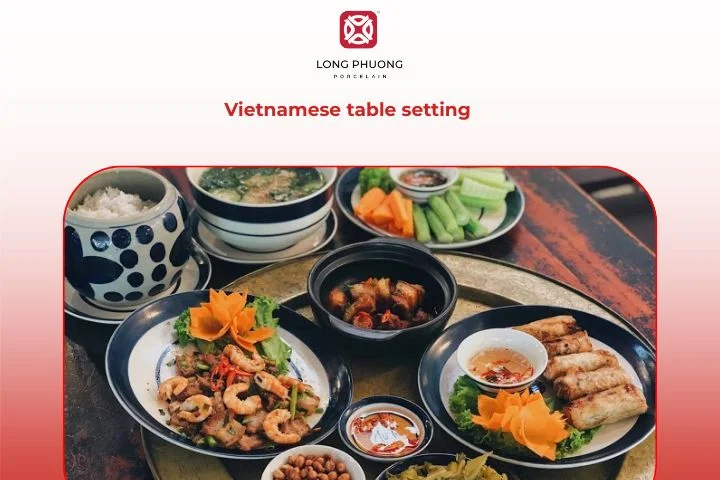
In Vietnam, meals are all about sharing and togetherness. The dining table often features a variety of dishes, soups, vegetables, meats, and dipping sauces, placed in the center for everyone to enjoy.
Each person’s spot includes:
- A rice bowl placed directly in front
- A soup bowl or small plate for side dishes
- A pair of chopsticks resting horizontally in front of the bowl
- A small spoon placed to the right
Condiments like nuoc mam (fish sauce) or chili paste are shared between diners. The Vietnamese table setting for Asian homes values simplicity, cleanliness, and symmetry. Using fine porcelain from Long Phuong Porcelain adds a polished, authentic look while keeping the warmth of traditional family meals.
3.2. Chinese table setting
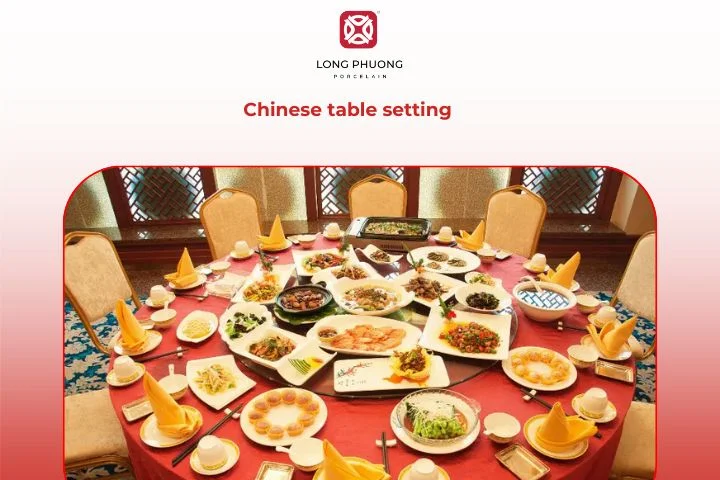
The Chinese dining tradition emphasizes harmony, abundance, and balance. Families often gather around a round table — a symbol of unity. A rotating Lazy Susan sits at the center for easy access to shared dishes.
Each place setting usually includes:
- A rice bowl in front of the diner
- A small plate for shared items
- A porcelain spoon to the right
- Chopsticks placed horizontally below the plate or bowl
Tea is integral to Chinese dining. Every guest receives a small porcelain tea cup, often served before or after the meal. When arranging a table setting for Asian cuisines, this ritual element brings elegance and cultural depth.
3.3. Japanese table setting

Japanese table setting for Asian meals are minimalist yet deeply symbolic. Each item has its designated position, representing order and mindfulness – core values in Japanese culture. A typical setup includes:
A typical setup includes:
- Rice bowl on the left
- Miso soup bowl on the right
- Main dish plate at the center
- Chopsticks laid horizontally below with tips facing left
Small side dishes (kobachi) are arranged in a balanced, aesthetic way. Japanese households often use simple white or natural-toned porcelain with subtle designs, reflecting wabi-sabi, beauty in simplicity.
When serving guests, remember that chopsticks should never be left sticking upright in rice, it’s considered bad luck. Instead, rest them neatly on a chopstick holder.
3.4. Korean table setting

Korean dining focuses on variety. The table is filled with banchan — small side dishes such as kimchi, pickled radish, and vegetables — all shared among diners.
Each guest’s setting includes:
- A rice bowl on the left
- A soup bowl on the right
- A spoon and chopsticks placed horizontally in front
Unlike other Asian settings, Koreans often use metal chopsticks and spoons instead of wooden or porcelain ones. Using coordinated porcelain side dishes enhances both the function and presentation of the Korean table setting for Asian style. The table’s symmetry and clean layout emphasize respect for food and companionship.
3.5. Thai table setting

Thai dining blends elegance and comfort. Meals feature multiple dishes served family-style, with a combination of spicy, sweet, and sour flavors.
Each place setting typically includes:
- A plate for rice (instead of a bowl)
- A fork and spoon, placed side by side — fork on the left, spoon on the right
- A small bowl for soups or desserts
Chopsticks are used only for noodle dishes. The resulting table setting for Asian meals in Thailand is a warm and festive atmosphere that highlights both hospitality and balance. The table’s centerpiece often features vibrant flowers or banana leaves for decoration.
3.6. Setting for international guests
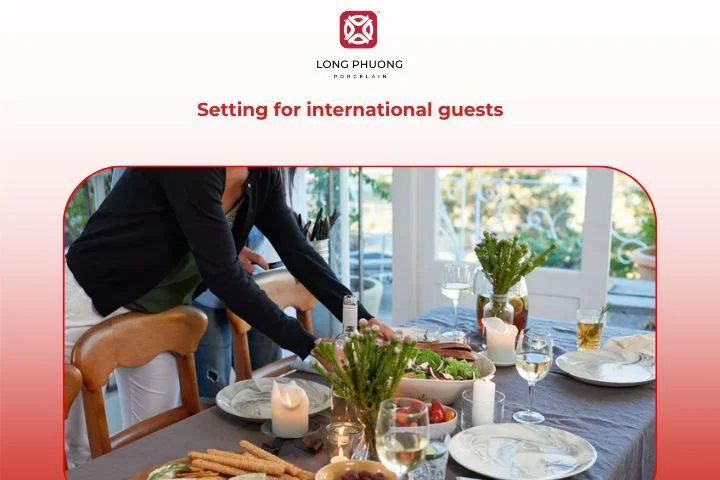
When hosting global guests, blending table setting for Asian cuisines with Western influences creates a welcoming fusion style.
To achieve this look:
- Keep the traditional Asian layout for rice bowls and chopsticks
- Add Western cutlery (forks, knives) for those less familiar with chopsticks
- Include napkins, glasses, and centerpieces to enhance sophistication
This style is ideal for Asian gala buffets or multicultural dinner events. For instance, you can serve Vietnamese spring rolls on porcelain platters beside Western-style cutlery, blending both worlds gracefully.
See more: complete guide to american table setting etiquette
4. Step-by-step guide to set an Asian dining table properly

A proper table setting for Asian cuisines is about balance and convenience. Follow these steps for an impeccable setup.
4.1. Step 1: Start with a clean and balanced layout
A spotless table sets the tone for an enjoyable meal. Lay a neutral or patterned tablecloth, ensuring everything feels balanced and centered.
4.2. Step 2: Position the rice bowl and soup bowl correctly
Place the rice bowl directly in front of the chair. If including a small individual soup bowl or starter bowl, place it to the right of the rice bowl (Vietnamese/Chinese) or slightly above it.
4.3. Step 3: Arrange chopsticks and spoon neatly on the right side
The primary utensils go on the right.
- Chopsticks: Place the chopsticks to the right of the bowl, parallel to the table edge, or diagonally with the thin ends pointing inward towards the bowl. If using a rest, place the rest horizontally in front of the bowl. Never place them sticking upright in the rice.
- Spoon: Place the spoon to the right of the chopsticks.
4.4. Step 4: Add plates and sauce dishes with intention
- Individual Plates: Place a small individual plate (for side dishes or appetizer) directly underneath the rice bowl, or to the left.
- Sauce Dishes: Place the small sauce dish slightly above and to the left of the rice bowl, easily reachable for dipping. Careful arrangement of these small pieces is essential for a refined table setting for Asian presentation.
4.5. Step 5: Include decorative touches for a welcoming atmosphere
Finish the setting by adding your chosen centerpiece, tea cups, water glasses, and napkins. Keep the centerpiece low to ensure everyone can see the shared dishes and one another.
5. 5 simple tips to make your Asian table setting stand out
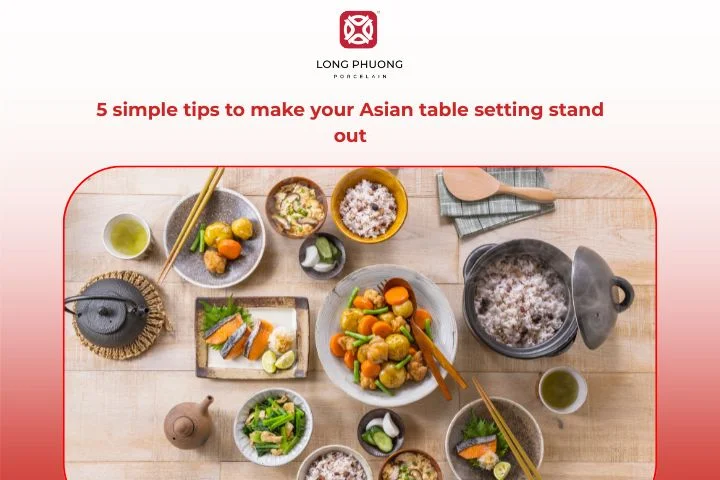
To truly elevate your dining area, start with a thoughtful table setting for Asian design. Elevate your casual family meal or make your buffet table for asian gala truly memorable with these styling tips.
5.1. Mix traditional and modern dinnerware
Don’t be afraid to blend classic porcelain dinnerware shapes with contemporary designs. A traditional patterned rice bowl paired with a sleek, minimalist serving platter creates a dynamic, updated look. This is a great way to respect tradition while embracing modern aesthetics.
5.2. Use natural colors and patterns for harmony
Asian design celebrates nature.
- Choose dinnerware in colors inspired by the earth and sea: soft blues, jade greens, deep browns, and classic white.
- Subtle patterns, like bamboo motifs or simple line borders, enhance harmony without overwhelming the food.
5.3. Add flowers, bamboo, or lanterns for a cozy Asian vibe
A simple centerpiece of a single orchid, a stalk of bamboo, or a cluster of small paper lanterns instantly adds an authentic, cozy Asian vibe.
5.4. Keep everything minimal but meaningful
The best Asian settings adhere to the principle of “less is more.” Use only the necessary pieces. For instance, a beautifully crafted porcelain rice bowl and an elegant pair of chopsticks on a small rest can be more impactful than a clutter of plates and cutlery.
5.5. Coordinate serving dishes for a unified look
Since the focus is on shared food, ensure your serving dishes complement your individual settings. Coordinating your dinnerware helps achieve a seamless and professional table setting for Asian look. Using the same line of porcelain for your platters, large soup bowls, and rice bowls creates a unified presentation.
6. Choosing the right porcelain dinnerware for Asian dining
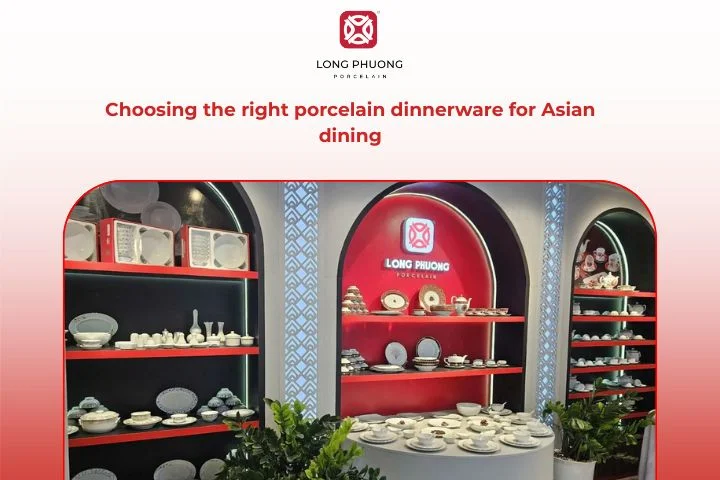
The quality of your dinnerware directly impacts the dining experience. When seeking the perfect table setting for Asian cuisine, porcelain is the material of choice for several reasons:
- Durability and Heat Retention: High-fired porcelain is incredibly durable, chip-resistant, and maintains the temperature of the food well—essential for shared soups and hot entrees.
- Aesthetics: The pure white color of quality porcelain, like that offered by Long Phuong Porcelain, provides the perfect neutral backdrop to let the vibrant colors of Asian food shine.
- Hygienic Surface: Porcelain’s non-porous nature makes it easy to clean and highly sanitary, an important consideration for communal dining.
Investing in a cohesive, high-quality porcelain set from a reputable manufacturer ensures your table setting for Asian cuisines is elegant, functional, and built to last.
7. FAQs about table setting for Asian dining
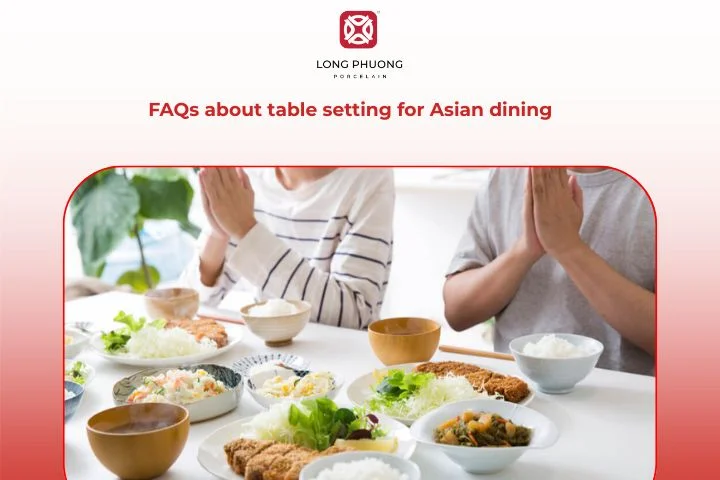
Understanding the fundamentals of the table setting for Asian dining is key to a successful host experience.
7.1. What is the proper Asian table setting?
A proper table setting for Asian includes a rice bowl, soup bowl, chopsticks, spoon, and sauce dish. Shared dishes are placed in the center.
7.2. What are the 7 essentials to table setting?
While this can vary by culture, the seven essentials for a general Asian setting are: rice bowl, chopsticks, spoon, individual plate (or side bowl), sauce dish, tea cup, and napkin.
7.3. What is a typical Chinese table setting?
A typical Chinese setting includes a rice bowl, a large soup spoon, a small dipping plate, and chopsticks (often on a chopstick rest). For formal banquets, the setting is arranged around a large central table often featuring a Lazy Susan to rotate the shared dishes.
7.4. What is the etiquette for Asian eating?
Key etiquette points include:
– Do not stick chopsticks vertically into your rice.
– Use the communal serving utensils (not your own chopsticks) to take food from shared dishes.
– Hold your rice bowl in your hand, near your mouth, while eating.
– Slurping noodles or soup is often acceptable, and sometimes a sign of enjoying the meal, particularly in Japan.
7.5. How can I make my table setting feel more authentic?
Use fine porcelain dinnerware, natural tones, and culturally inspired decor like bamboo mats or lotus flowers.
Related articles
CEO of Long Phuong Group Joint Stock Company, with more than 20 years of exploration and research to obtain the best formulas and professional experience, Long Phuong Porcelain has produced more than 400 designs of all kinds of household porcelain, Significant contributions to Vietnam's ceramic industry.
 Vietnam
Vietnam
